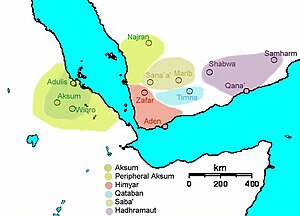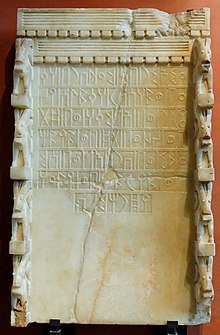
http://www.catholic-convert.com/2011/12/23/finding-the-church-in-abrahams-home-of-ur-in-iraq-a-soldier-finds-the-truth-4000-years-later/
When the wise men came to the Star of Venus or Light Start there journey was two years seven months before birth .
The Arch Angel guided them though the long day night . Then land of Al Shahri the gates of Juilbeil
Qataban (Arabic,مملكة قتبان) was one of the ancient Yemeni kingdoms. Its heartland was located in the Baihan valley.
Like some other Southern Arabian kingdoms it gained great wealth from the trade of frankincense and myrrh incense which were burned at altars.
The capital of Qataban was named Timna and was located on the trade route which passed through the other kingdoms of Hadramaut, Sheba and Ma'in.
The chief deity of the Qatabanians was Amm, or "Uncle" and the people called themselves the "children of Amm".
It was the most prominent Yemeni kingdom in the 2nd half of the 1st millennium BCE, when its ruler held the title of the South Arabian hegemon, MKRB.
[Bibliography
- Alessandro de Maigret. Arabia Felix, translated Rebecca Thompson. London: Stacey International, 2002. ISBN 1-900988-07-0
- Andrey Korotayev. Ancient Yemen. Oxford: Oxford University Press, 1995. ISBN 0-19-922237-1.
- Andrey Korotayev. Pre-Islamic Yemen. Wiesbaden: Harrassowitz Verlag, 1996. ISBN 3-447-03679-6.
- Andrey Korotayev. Socio-Political Conflict in the Qatabanian Kingdom? (A re-interpretation of the Qatabanic inscription R 3566) // Proceedings of the Seminar for Arabian Studies 27 (1997): 141–158.
These kingdom are the original Arabian people and the moon which is UR =======
The mush Arab were the original sentence to be killed in in 1968 by the Skull and Bones ======
and the Mason 's to full the agenda ;s which are written 165 year solar cycles which are mandated down 120 years
Sabaeans
The Sabaeans or Sabeans (Arabic: السبأيون as-Saba’iyūn) were an ancient people speaking an Old South Arabian language who lived in what is today Yemen, in the south west of the Arabian Peninsula.[1]
Some scholars suggest a link between the Sabaeans and the Biblical land of Sheba, and would dismiss any link or confusion with the Sabians.[1]
Contents[hide] |
History

The ancient Sabaean Kingdom established power in the early 1st millennium BC. In the 1st century BC it was conquered by the Himyarites, but after the disintegration of the first Himyarite empire of the Kings of Saba' and Dhu-Raydan, the Middle Sabaean Kingdom reappeared in the early 2nd century. It was finally conquered by the Himyarites in the late 3rd century. Its capital was Ma'rib. The kingdom was located along the strip of desert called Sayhad by medieval Arab geographers, which is now named Ramlat al-Sab`atayn.
The Sabaean people were South Arabian people. Each of these had regional kingdoms in ancient Yemen, with the Minaeans in the north along the Red sea, the Sabeans on the south western tip, stretching from the highlands to the sea, the Qatabanians to the east of them and the Hadramites east of them.
The Sabaeans, like the other Yemenite kingdoms of the same period, were involved in the extremely lucrative spice trade, especially frankincense and myrrh.[2]
They left behind many inscriptions in the monumental Musnad (Old South Arabian) alphabet, as well as numerous documents in the cursive Zabur script.
In the Res Gestae Divi Augusti, Augustus claims that:
By my command and under my auspices two armies were led at about the same time into Ethiopia and into Arabia, which is called the Blessed [?]. Great forces of each enemy people were slain in battle and several towns captured. In Ethiopia the advance reached the town of Nabata, which is close to Meroe; in Arabia the army penetrated as far as the territory of the Sabaeans and the town of Mariba.[3]
The Sabaeans are referenced in the Book of Job for slaughtering the livestock and servants of the eponymous character.[4]
See also
Notes
- ^ a b Stuart Munro-Hay, Aksum: An African Civilization of Late Antiquity, 1991.
- ^ Yemen
- ^ Res Gestae Divi Augusti, paragraph 26.5, translation from Wikisource
- ^ [1]
References
- Bafaqīh, M. ‛A., L'unification du Yémen antique. La lutte entre Saba’, Himyar et le Hadramawt de Ier au IIIème siècle de l'ère chrétienne. Paris, 1990 (Bibliothèque de Raydan, 1).
- Andrey Korotayev. Ancient Yemen. Oxford: Oxford University Press, 1995. ISBN 0-19-922237-1 [2].
- Andrey Korotayev. Pre-Islamic Yemen. Wiesbaden: Harrassowitz Verlag, 1996. ISBN 3-447-03679-6.
- Ryckmans, J., Müller, W. W., and ‛Abdallah, Yu., Textes du Yémen Antique inscrits sur bois. Louvain-la-Neuve, 1994 (Publications de l'Institut Orientaliste de Louvain, 43).
- Info Please
- Article at Encyclopædia Britannica
External links
- S. Arabian "Inscription of Abraha" in the Sabaean language, at Smithsonian/NMNH website


No comments:
Post a Comment